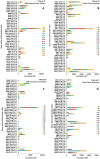Analysis of an ordered, comprehensive STM mutant library in infectious Borrelia burgdorferi: insights into the genes required for mouse infectivity
- PMID: 23133514
- PMCID: PMC3485029
- DOI: 10.1371/journal.pone.0047532
Analysis of an ordered, comprehensive STM mutant library in infectious Borrelia burgdorferi: insights into the genes required for mouse infectivity
Abstract
The identification of genes important in the pathogenesis of Lyme disease Borrelia has been hampered by exceedingly low transformation rates in low-passage, infectious organisms. Using the infectious, moderately transformable B. burgdorferi derivative 5A18NP1 and signature-tagged versions of the Himar1 transposon vector pGKT, we have constructed a defined transposon library for the efficient genome-wide investigation of genes required for wild-type pathogenesis, in vitro growth, physiology, morphology, and plasmid replication. To facilitate analysis, the insertion sites of 4,479 transposon mutants were determined by sequencing. The transposon insertions were widely distributed across the entire B. burgdorferi genome, with an average of 2.68 unique insertion sites per kb DNA. The 10 linear plasmids and 9 circular plasmids had insertions in 33 to 100 percent of their predicted genes. In contrast, only 35% of genes in the 910 kb linear chromosome had incapacitating insertions; therefore, the remaining 601 chromosomal genes may represent essential gene candidates. In initial signature-tagged mutagenesis (STM) analyses, 434 mutants were examined at multiple tissue sites for infectivity in mice using a semi-quantitative, Luminex-based DNA detection method. Examples of genes found to be important in mouse infectivity included those involved in motility, chemotaxis, the phosphoenolpyruvate phosphotransferase system, and other transporters, as well as putative plasmid maintenance genes. Availability of this ordered STM library and a high-throughput screening method is expected to lead to efficient assessment of the roles of B. burgdorferi genes in the infectious cycle and pathogenesis of Lyme disease.
Conflict of interest statement
Figures






References
-
- Samuels DS, Radolf JD (2010) Borrelia: Molecular Biology, Host Interaction and Pathogenesis. Hethersett, Norwich, UK: Caister Academic Press.
-
- Lane RS, Piesman J, Burgdorfer W (1991) Lyme borreliosis: relation of its causative agent to its vectors and hosts in North America and Europe. Annu Rev Entomol 36: 587–609. - PubMed
-
- Fraser CM, Casjens S, Huang WM, Sutton GG, Clayton R, et al. (1997) Genomic sequence of a Lyme disease spirochaete, Borrelia burgdorferi . Nature 390: 580–586. - PubMed
-
- Casjens S, Palmer N, van Vugt R, Huang WM, Stevenson B, et al. (2000) A bacterial genome in flux: the twelve linear and nine circular extrachromosomal DNAs in an infectious isolate of the Lyme disease spirochete Borrelia burgdorferi . Mol Microbiol 35: 490–516. - PubMed
Publication types
MeSH terms
Substances
Grants and funding
LinkOut - more resources
Full Text Sources

